Written by Tracy Dion for Raw Instincts Magazine, October 2012.
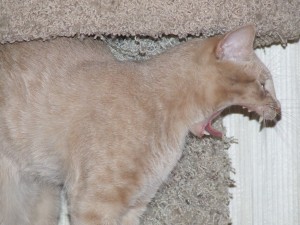 Commercial or home-prepared, canned or raw, all balanced feline diets must contain whole bone or a substitute supplement. Unfortunately, the pet food industry began a highly successful campaign of misinformation in the 1980’s that was critical of feeding “people food” in general and bones in particular. Today, just the thought of bones makes pet owners shudder, and many neophyte raw feeders shy away from offering bone-in meals to their beloved kitties for fear of harming them.
Commercial or home-prepared, canned or raw, all balanced feline diets must contain whole bone or a substitute supplement. Unfortunately, the pet food industry began a highly successful campaign of misinformation in the 1980’s that was critical of feeding “people food” in general and bones in particular. Today, just the thought of bones makes pet owners shudder, and many neophyte raw feeders shy away from offering bone-in meals to their beloved kitties for fear of harming them.
Supplements are a poor substitute for the real thing, however, and every effort should be made to overcome these fears and allow cats the full natural expression of their carnivorous natures.
Why is whole bone important?
Nutrients
Bone is composed of a handful of elements, but about 65 to 70 percent is comprised of the minerals Calcium and Phosphorus, which together form a calcium phosphate microcrystalline structure. Collagen, a fibrous protein, and small amounts of Chondroitin Sulfate, Keratin Sulfate and Phospholipids, make up the remaining 30 to 35 percent.
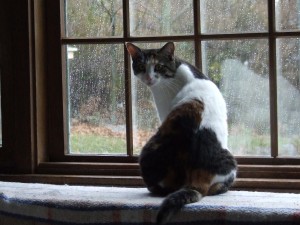 Calcium and Phosphorus are critical for the health of a cat’s bones and teeth. Of all the minerals, however, Calcium is required in the greatest amount, especially in growing kittens. In addition to bones and teeth, it is essential for many functions including blood clotting, muscle contraction – such as the heart’s pumping – and strength, and nerve impulse transmission. In addition, Calcium is used to help blood vessels move blood and to release hormones and enzymes that affect almost every function in the body. Nursing females need it to produce sufficient levels of milk.
Calcium and Phosphorus are critical for the health of a cat’s bones and teeth. Of all the minerals, however, Calcium is required in the greatest amount, especially in growing kittens. In addition to bones and teeth, it is essential for many functions including blood clotting, muscle contraction – such as the heart’s pumping – and strength, and nerve impulse transmission. In addition, Calcium is used to help blood vessels move blood and to release hormones and enzymes that affect almost every function in the body. Nursing females need it to produce sufficient levels of milk.
Phosphorus is also very important, but is found in fairly high concentrations in meat. Phosphorus deficiencies are rarely noted in cats offered high-protein diets.
Bone marrow is mostly a fat and blood mixture full of amino acids and other high quality nutrients, and the cartilage that clings to bone is about 50 percent Collagen. Collagen is important for a number of bodily processes and is the main component of skin, ligaments and tendons. Adequate Collagen in the diet inhibits joint pain, improves skin elasticity and promotes quicker healing of bone fractures and skin wounds.
Feeding these elements in their natural form is the most effective and easiest way to ensure optimal digestion and absorption of the full nutrient profile.
And raw bone-in meals offer much more than just their basic nutrients.
Dental Health
Eating whole bone offers unparalleled oral health benefits. Dental disease is at near-epidemic levels in the feline population – it’s estimated that more than 85 percent of cats over three years old are suffering from periodontal disease – and has far reaching health consequences. Toxins and bacteria from the mouth travel throughout the bloodstream, stressing the immune system and infecting other organs, especially the heart and kidneys. Dental disease contributes to other diseases that can be fatal. Teeth rot and cause intense pain that can go unnoticed for months, even years. Around 30 to 40 percent of healthy adult cats suffer from Feline Tooth Resorptive Lesions, sometimes referred to as FORLS, a painful condition in which the teeth are slowly destroyed from the outside in, and many others are inflicted with Feline Stomatitis, an autoimmune disorder that causes painful inflammation of the mouth and throat tissues
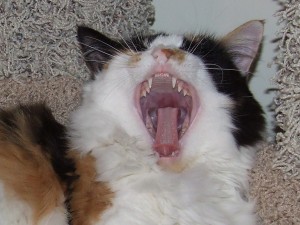 A diet that includes tearing, ripping and scissoring through raw meat, tendons and bones provides the necessary stimulation to keep the cat’s mouth clean and healthy. The firm resistance of these foods increases the number, distribution, and tone of the capillaries in the gums, improving the metabolism and vitality of all of the supporting and surrounding structures of the cat’s mouth. The scraping action of the bones, muscle meats and tendons keeps the teeth clean and prevents food build-up, gingivitis and periodontal disease. A diet that includes whole bone is the single most effective method for preventing dental disease, and can even reverse some damage and restore health to the oral cavity.
A diet that includes tearing, ripping and scissoring through raw meat, tendons and bones provides the necessary stimulation to keep the cat’s mouth clean and healthy. The firm resistance of these foods increases the number, distribution, and tone of the capillaries in the gums, improving the metabolism and vitality of all of the supporting and surrounding structures of the cat’s mouth. The scraping action of the bones, muscle meats and tendons keeps the teeth clean and prevents food build-up, gingivitis and periodontal disease. A diet that includes whole bone is the single most effective method for preventing dental disease, and can even reverse some damage and restore health to the oral cavity.
The alternative is brushing the cat’s teeth daily, something most feline owners find stressful for the cat and hazardous to their own health.
Digestive and Mental Health
In addition to the near-irreplaceable oral health benefits, the very act of scissoring through raw meat and bone sets off a physiological chain reaction that releases a highly efficient combination of enzymes in the cat’s digestive system and this, combined with the extended time required to finish the meal, promotes a better digestive process. The cat’s meals are assimilated with more efficacy, as every bit of nutrition is absorbed from her food.
Finally, there is substantial anecdotal evidence this active engagement in the eating process has several psychological benefits to the cat, including the satisfaction inherent in successfully meeting mental and physical challenges – eating becomes work! Cats fed a diet of meat chunks and whole bone seem to be calmer and less prone to aggression and discontent.
Risks
No act in life is risk free, but offering your cat raw bone-in meals carries not much more risk of choking than offering her kibble. Raw bones are soft and pliable and it is unlikely a cat will choke on them. Cats evolved to eat animals, bones and all, and most of them instinctively know how to go about it.
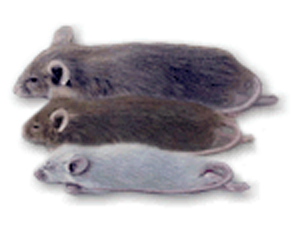 Chicken ribs or other bone-in meals cut too small may occasionally get stuck to the roof of the cat’s mouth or go down her throat sidewise, and inexperienced cats may try to swallow too-large a piece of bone-in meal. The former may cause panic until the cat can dislodge the food, and the later will cause the cat to regurgitate what she unsuccessfully tried to swallow (after which, she’ll usually re-eat the meal in more manageable bites). Both of these can be avoided by offering pieces that are too large to be swallowed in one gulp, forcing the cat to cut her food into perfectly bite sized and easily swallowed pieces.
Chicken ribs or other bone-in meals cut too small may occasionally get stuck to the roof of the cat’s mouth or go down her throat sidewise, and inexperienced cats may try to swallow too-large a piece of bone-in meal. The former may cause panic until the cat can dislodge the food, and the later will cause the cat to regurgitate what she unsuccessfully tried to swallow (after which, she’ll usually re-eat the meal in more manageable bites). Both of these can be avoided by offering pieces that are too large to be swallowed in one gulp, forcing the cat to cut her food into perfectly bite sized and easily swallowed pieces.
You can virtually eliminate the chance of a chipped or broken tooth by feeding only thin and non-weight-bearing bones; think of the bones you would find in a mouse, bird or small rabbit. A good rule of thumb for bone size or density: if you can’t cut it with shears, don’t feed it to your cat.
Of course, never, ever feed your cat cooked bones, as they are brittle and can cause serious damage when eaten.
Transitioning
A domestic cat’s natural diet consists of about 5 to 7 percent whole bone – rodents are roughly 5 percent bone, birds are slightly less and rabbits run just under 10 percent – and most prey model raw diets recommend 5 – 10 percent edible bone.
Always leave meat on the bones! It’s how those bones are packaged in the wild and how you should offer them to your cat. This will encourage her to eat the meal and facilitate the smooth movement of the food when she swallows.
To transition, start with very small bones, like the ribs and wings from a Cornish Hen or half a quail (note – small bones, not small bites!). Cats fed commercial products all their lives need to learn how to use their jaws and teeth to scissor through meat and bones, and they have to build up their jaw strength to be able to do so. They also get discouraged fairly easily, so you want to start with the easiest bone-in meals you can offer.
Transition slowly, over a few weeks, to give the cat’s digestive system time to readjust to working at peak efficiency. If your cat throws up bones or you find a bit of bone in the stool, slow the transition even further.
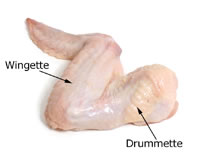 Once your cat is familiar and comfortable with Cornish Hen and quail-sized bones, you can move up to chicken ribs and wings. Estimating how much bone each cat needs can be difficult, but a good rule of thumb is offering three bone-in meals a week (assuming you’re feeding three meals a day). Half the edible bone on a chicken breast with ribs, or the tip and two middle bones of a chicken wing (the “wingette”) both make suitably-sized bone-in meals for most cats. You can use that as your starting point and adjust from there.
Once your cat is familiar and comfortable with Cornish Hen and quail-sized bones, you can move up to chicken ribs and wings. Estimating how much bone each cat needs can be difficult, but a good rule of thumb is offering three bone-in meals a week (assuming you’re feeding three meals a day). Half the edible bone on a chicken breast with ribs, or the tip and two middle bones of a chicken wing (the “wingette”) both make suitably-sized bone-in meals for most cats. You can use that as your starting point and adjust from there.
Determine how much adjusting you need to do by watching your cat’s litter box. Firm but moist stools are perfect. Stools that are hard typically require a bit less bone in the diet and those that are loose require more; try not to exceed 10 percent, however, as excessive amounts of bone can cause constipation.
Conclusion
The importance of raw bone-in meals is clear. Their nutrients are critical to good health and provided in the perfect combination and form for maximum utilization. The flossing and cleaning of the teeth and gums promotes dental health and supports the immune system, and a clean, bacteria- and toxin-free mouth minimizes stress upon the cat’s organs. The evidence for digestive and mental health benefits is compelling, and there is minimal risk involved in offering appropriately-sized bone-in meals.
Raw bones are neither dangerous nor scary, so why not let your kitty release her inner tiger by ripping into a real meat and bones meal tonight?
If you enjoyed this article or found it informative, please “Like” it, “Tweet” it, or share it using any of the buttons below. And don’t forget to check out our FB page, join the discussions in our awesome FB group and follow us on Twitter!
Created 10/08/12; Updated 08/11/14

